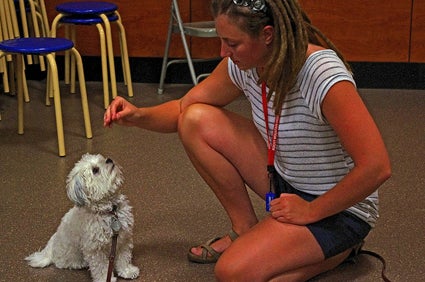What is Positive Reinforcement Training

If you speak to ten different dog trainers, you will get ten different recommendations. When it comes to dog training there are many different methods, but some of the most successful trainers follow the same core principles of training. Many trainers and animal behaviorists agree that positive reinforcement training is the most effective (and the most humane) form of dog training out there.
What is Positive Reinforcement Training?
The core principle behind positive reinforcement training is the idea that dogs will be more likely to repeat a behavior if they are rewarded for it. Think of it this way – if you try something that ends up having a positive result, aren’t you more likely to try it again in the future than you would be if it had a negative result?
The same is true for dogs. You can encourage, or reinforce, a specific behavior by rewarding your dog for performing that behavior. The key to positive reinforcement dog training is to pair the behavior with a command (like Sit or Stay) and to help your dog learn to associate the behavior with that command. By immediately rewarding your dog for performing the desired behavior, you are teaching him exactly what you expect when you give him a specific command and you are encouraging him to repeat that behavior.
Where did Positive Reinforcement Training Come From?
Once upon a time it was a common belief that dogs needed to be “broken” by their owners – punishment was heavily used in dog training in methods similar to the modern Alpha dog style of training popularized by Cesar Milan, the “Dog Whisperer”. During the 1980s, however, there was a shift toward more positive methods of dog training when methods of operant conditioning became more commonplace. Operant conditioning was by no means a new theory, but it regained popularity after it had fallen out of fashion sometime during the 1800s. The first person to extensively study operant conditioning was Edward L. Thorndike.
During the early 1900s, Thorndike studied what he called the “law of effect”. He observed the behavior of feline test subjects trying to escape from a puzzle box – they could escape the box by pulling a cord. As the cats worked their way through ineffective responses and began to identify the successful response they began to escape from the box more quickly. B.F. Skinner studied a similar principle using pigeons and rats, using various forms of reinforcement to encourage specific responses. Negative reinforcement involved removing an aversive stimulus in response to a particular behavior while positive reinforcement involved issuing a positive reward following the desired behavior.
This style of positive reinforcement-based training soon came to be utilized by dog trainers and it is still considered to be one of the most effective forms of training. When utilized correctly, some of the more intelligent dog breeds (like the Poodle or Labrador Retriever) can make the association between the command and the desired behavior in as few as three repetitions when using positive reinforcement methods. Crate training, a popular method for housetraining puppies, is also based on positive reinforcement and is considered a highly effective method for training.
The style of training you choose for your dog is entirely a matter of your own preference but you should take the time to study the options before you choose. If you do, you will probably find that positive reinforcement is not only the most effective option but it will also help you strengthen your bond with your dog whereas punishment-based methods might actually harm your relationship.
Photo credit: janeannv/Flickr
Please consult the services of a Professional Dog Trainer, Behaviorist or Veterinarian before implementing any of the advice contained on this site.










 Your Privacy Choices
Your Privacy Choices